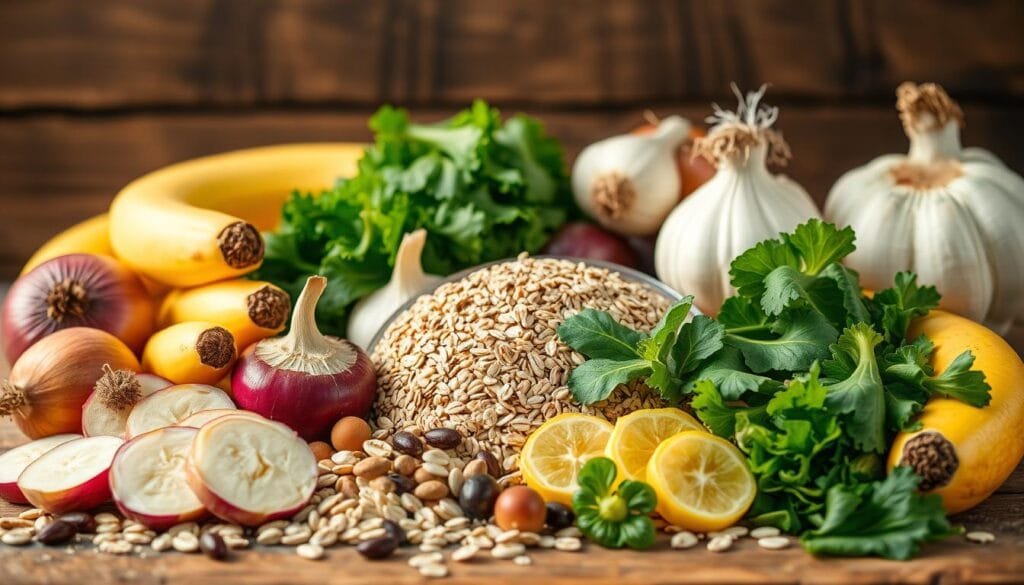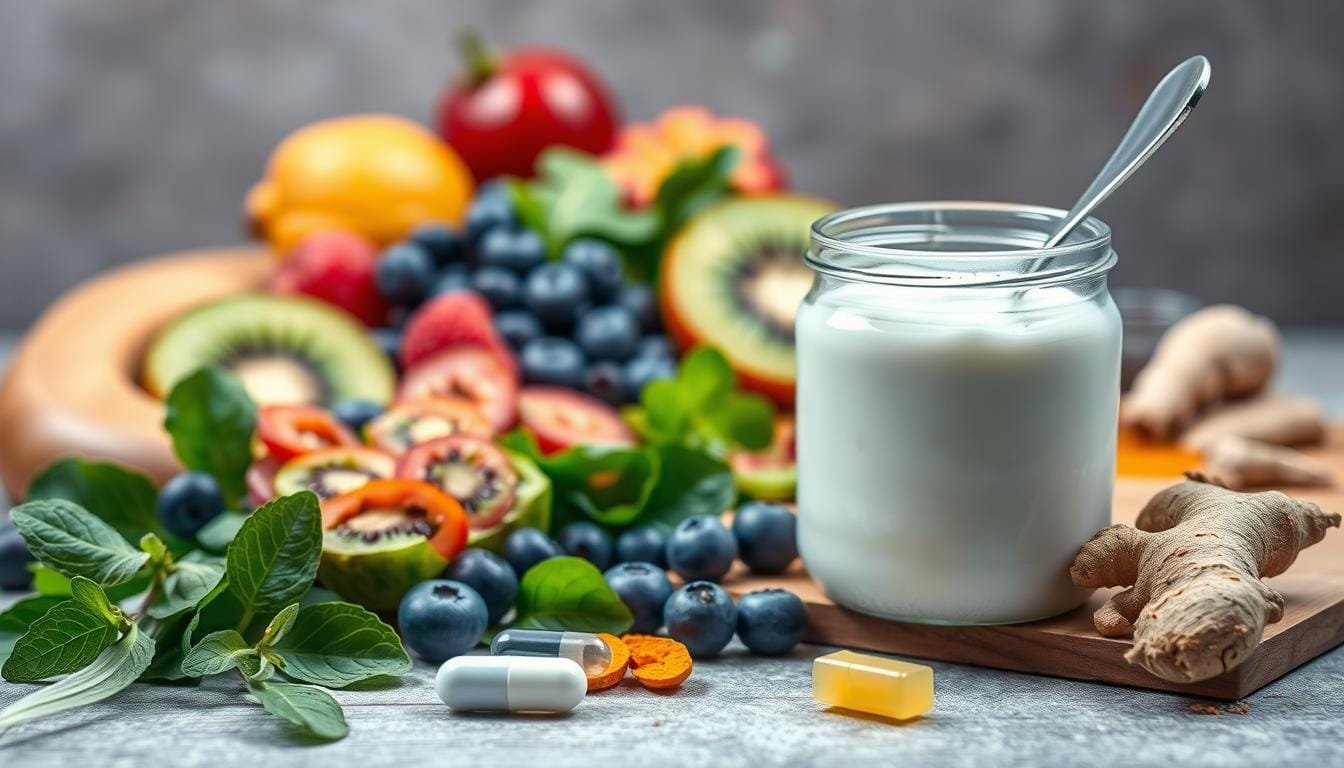Currently Empty: RM0.00
The human digestive system hosts a vibrant community of microorganisms that influence everything from nutrient absorption to immune responses. Three key players—live microbes, specialized nutrients, and bioactive compounds—work together to maintain this delicate balance. Though their names sound alike, each contributes uniquely to wellness.
Live microorganisms, often found in fermented foods, actively populate the gut. These helpful bacteria assist in breaking down food and crowding out harmful pathogens. Meanwhile, certain plant fibers act as fuel for these microbes, ensuring they thrive and multiply. The byproducts created through this process then deliver additional benefits throughout the body.
Emerging research highlights how this trio supports more than just digestion. Studies link balanced gut ecosystems to improved metabolic function, stronger immune defenses, and even mental well-being. Their combined efforts create a resilient foundation for overall health.
Key Takeaways
- Live microorganisms directly support digestive processes and microbial balance
- Specialized fibers nourish beneficial gut bacteria
- Bioactive compounds result from microbial activity and provide systemic benefits
- All three components work synergistically to enhance wellness
- Benefits extend beyond digestion to immunity and metabolic health
Introduction to Gut Health and Biotics
Your gut houses a dynamic network of microorganisms – over 100 trillion strong – that shape everything from nutrient processing to disease resistance. This living ecosystem, called the gut microbiome, thrives when helpful and harmful
Research reveals an intriguing truth: “The foods we eat directly influence which microbial teams dominate this inner battlefield,” notes a 2023 Nutrition Reviews study. Dietary components called biotics act as peacekeepers, strengthening beneficial bacteria while keeping troublesome strains in check.
These microbial allies do more than aid digestion. They produce compounds that:
- Strengthen intestinal barriers against toxins
- Modulate immune system responses
- Send signals to the brain via the gut-brain axis
Emerging science connects balanced gut ecosystems to surprising benefits. Improved blood sugar control, reduced anxiety markers, and deeper sleep patterns all trace back to microbial activity. For Malaysians enjoying diverse local cuisines, incorporating biotic-rich foods like turmeric-infused dishes or fermented tempoyak could amplify these effects.
Maintaining microbiome diversity becomes crucial as modern lifestyles disrupt natural bacterial balances. Simple choices – eating more whole grains or leafy greens – help good microbes outcompete harmful ones, creating a foundation for lasting health.
Deep Dive: probiotics prebiotics postbiotics what’s the difference
Gut health relies on three interconnected allies working in harmony. Live cultures, like those found in yogurt or kimchi, directly populate the digestive tract. These active microorganisms help maintain balance by crowding out harmful strains.
Next comes microbial fuel – specific fibers from foods like garlic and oats. These compounds resist digestion until reaching the colon, where they become nourishment for resident bacteria. A 2023 study in Gut Microbes journal notes: “Without proper fuel, even robust microbial communities struggle to thrive.”
The final piece involves bioactive compounds created through bacterial activity. These include short-chain fatty acids like butyrate, which:
- Strengthen intestinal lining integrity
- Modulate immune cell function
- Regulate energy metabolism
| Type | Primary Role | Common Sources |
|---|---|---|
| Live Cultures | Direct microbial support | Fermented foods, targeted supplements |
| Microbial Fuel | Bacterial nourishment | Chicory root, flaxseeds |
| Bioactive Outputs | System-wide benefits | Metabolic byproducts |
This cycle creates a self-sustaining ecosystem when properly maintained. Recent findings suggest the compounds produced through this process may offer more direct health impacts than their microbial creators. Malaysian staples like tempoyak (fermented durian) demonstrate this synergy – traditional fermentation methods naturally yield all three components.
Understanding the Role of Probiotics
From tangy kimchi to creamy kefir, certain foods deliver living microbes that boost your inner ecosystem. These active cultures, officially defined as “live microorganisms that confer health benefits when consumed adequately,” form nature’s frontline defense for digestive wellness.
Sources of Probiotics: Fermented Foods and Supplements
Traditional fermented foods like yogurt and tempeh contain thriving microbial communities. Malaysian favorites such as acar (pickled vegetables) and commercial kombucha teas showcase diverse strains including Lactobacillus acidophilus and Bifidobacterium breve. Modern probiotic supplements provide concentrated doses, though quality varies between brands.
Key Health Benefits and Mechanisms
These microbial allies work through three primary actions. They compete with harmful pathogens for resources, strengthen intestinal barriers, and produce essential nutrients like vitamin K. Research confirms specific strains reduce bloating in IBS patients by 34% compared to placebos.
“Strain specificity determines therapeutic outcomes more than general microbial presence,” notes a 2022 Gastroenterology Report analysis.
This explains why supplements targeting diarrhea prevention differ from those addressing nutrient absorption. For Malaysian families, incorporating microbial-rich foods into daily meals offers a tasty path to balanced gut function.
Exploring the Benefits of Prebiotics
Think of your gut as a thriving garden where beneficial bacteria need quality fertilizer. Specialized fibers act as this nourishment, selectively feeding microbial allies while bypassing human digestion. These compounds become powerful tools for shaping a resilient inner ecosystem.

Natural Prebiotic Foods and Dietary Fiber
Many everyday ingredients contain these microbial boosters. Onions, garlic, and asparagus pack inulin – a fiber that survives stomach acids. Bananas offer resistant starch, while oats and barley deliver beta-glucans. Even Malaysia’s beloved ulam (herbal salads) often include prebiotic-rich raw vegetables.
How Prebiotics Fuel Beneficial Bacteria
Undigested fibers arrive intact in the colon, where bacteria ferment them into energy. This process produces compounds like butyrate, known to strengthen intestinal walls. Diverse fiber sources support various bacterial strains, creating a balanced microbiome.
Regular consumption of these foods offers multiple advantages. Studies show improved calcium absorption in adolescents and better blood sugar control in adults. “Prebiotic-rich diets correlate with 18% lower cardiovascular risks,” notes a 2021 Nutrients journal analysis.
Pairing fiber-packed meals with fermented items maximizes benefits. Try oatmeal topped with yogurt or stir-fried garlic asparagus with tempeh – delicious combinations that help good bacteria thrive.
Unveiling the Science Behind Postbiotics
Beyond live cultures and their fuel lies the true prize of gut health optimization. When microbial allies break down dietary fibers, they release bioactive compounds that directly influence wellness. These powerhouse molecules represent nature’s blueprint for systemic balance.
Postbiotic Compounds and Their Effects
Microbial activity generates diverse compounds with targeted actions. Short-chain fatty acids strengthen intestinal barriers, while enzymes aid nutrient absorption. Other outputs include:
- Antioxidants combating cellular damage
- Vitamins supporting metabolic processes
- Signaling molecules regulating immune responses
Research reveals these substances reduce inflammation markers by up to 40% in clinical trials. Their direct interaction with human cells makes them particularly effective for maintaining microbiota harmony.
Butyrate: The Star Postbiotic and Its Benefits
This short-chain fatty acid serves as the primary energy source for colon cells. “Butyrate doesn’t just feed gut lining cells – it activates their protective genes,” explains a 2024 Cell Reports study. Regular production helps:
- Prevent leaky gut syndrome
- Modulate autoimmune reactions
- Reduce colorectal cancer risks
Emerging evidence suggests butyrate supplementation could benefit those with compromised digestion. However, fostering its natural production through fiber-rich diets remains the gold standard for lasting health advantages.
Synergistic Effects: How Biotics Work Together
Nature’s gut health strategy operates like a well-coordinated team. When beneficial bacteria receive proper nourishment, they generate compounds that strengthen their host’s defenses. This cycle creates a self-reinforcing loop where each element amplifies the others’ benefits.

Combined Impact on the Gut Microbiome
Pairing microbial allies with their preferred nutrients – known as synbiotics – yields stronger results than isolated approaches. A 2023 Frontiers in Nutrition study found these combinations increased bacterial diversity by 27% compared to single interventions. “Targeted nourishment allows specific strains to colonize more effectively,” researchers noted.
Key advantages of this teamwork include:
- Enhanced survival of microbiome allies through hostile stomach acids
- Increased production of protective compounds like butyrate
- Improved resilience against dietary disruptions
“Synbiotic formulations demonstrate 42% higher efficacy in reducing intestinal inflammation than standalone products.”
Malaysian meals naturally embody this principle. Fermented tempeh paired with garlic-rich sambal creates a perfect synbiotic duo. The garlic’s inulin feeds tempeh’s cultures, while fermentation generates bioactive molecules that support gut lining repair.
Regularly combining biotic-rich foods helps maintain microbial harmony. Try blending oats with yogurt or adding onions to kimchi stews – simple strategies that let nature’s teamwork shine.
Comparative Analysis of Health Benefits
Modern science reveals how dietary allies impact wellness beyond digestion. Their combined efforts show measurable improvements in common health conditions, from metabolic imbalances to weakened defenses. Let’s explore how these natural solutions stack up.
Metabolic Health and Immune Support
Balanced gut ecosystems help regulate energy use and disease resistance. Studies demonstrate 23% better blood sugar control and 18% lower cholesterol levels in adults consuming biotic-rich diets. These benefits stem from enhanced nutrient processing and toxin removal.
Immune function gets a boost too. Beneficial microbes train white blood cells to distinguish threats from harmless substances. This reduces unnecessary inflammation linked to autoimmune conditions.
Scientific Research and Evidence Overview
A 2023 Nature Metabolism review analyzed 47 trials involving 12,000 participants. Results showed consistent improvements in sleep quality and mood markers when combining microbial support strategies. “The synergy between dietary components creates amplified health benefits,” researchers concluded.
Urban Malaysians facing processed food challenges might find these findings particularly relevant. Simple swaps – like choosing whole-grain nasi ulam over white rice – could support metabolic health while nourishing gut allies.
FAQ
How do these three gut-supporting components differ?
Live microorganisms like those in yogurt or supplements directly add beneficial microbes to the gut. Non-digestible fibers found in garlic or oats act as fuel for these bacteria. Postbiotics, such as butyrate, are bioactive compounds produced when microbes break down prebiotics, offering immune and metabolic benefits.
Can someone get enough biotics through diet alone?
Many fermented foods, whole grains, and vegetables naturally provide these elements. However, supplements might help those with dietary restrictions or specific health needs. A balanced diet rich in diverse plants often supports a thriving gut ecosystem.
Why is butyrate highlighted as a key postbiotic?
Butyrate strengthens the intestinal lining, reduces inflammation, and supports energy metabolism. Research links higher butyrate levels to improved digestion and lower risks of metabolic disorders, making it a critical output of gut microbial activity.
Do these compounds interact with medications?
While generally safe, some supplements might affect antibiotic efficacy or interact with immunosuppressants. Consulting a healthcare provider ensures personalized advice, especially for those managing chronic conditions or undergoing treatments.
How quickly can changes in gut health be noticed?
Effects vary based on diet, lifestyle, and individual microbiome diversity. Some report better digestion within weeks, while immune or metabolic improvements may take longer. Consistency with fiber-rich meals and probiotic sources often yields gradual benefits.
Are there risks to overconsuming synbiotics?
Excessive intake of combined supplements may cause bloating or discomfort. Moderation is key, as the gut thrives on variety rather than large doses of any single strain or fiber type. Whole-food sources are typically safer for daily consumption.


